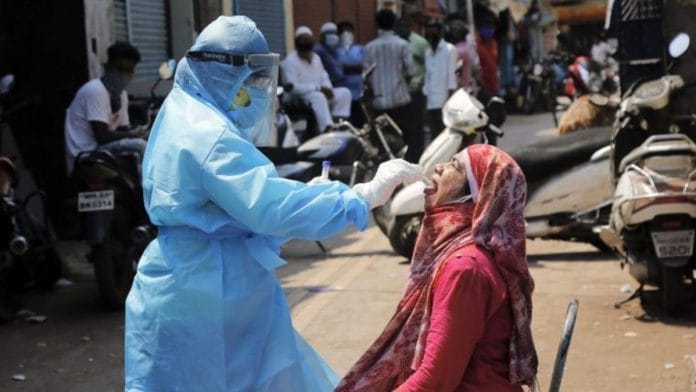Mumbai: The Maharashtra capital, which has so far been a hotspot for the first two waves of the Covid pandemic in India, has shown a slight uptick in the number of new cases in the past eight days, after the state government relaxed restrictions for public transport, private offices and the hospitality sector.
From 25 August, the number of new daily Covid positive cases in Mumbai has been consistently crossing the 300-mark, and even breached 400 on 1 September, when the city reported 416 new Covid cases, according to data from the Brihanmumbai Municipal Corporation (BMC).
Overall, in the eight days from 25 August to 1 September, Mumbai saw 2,910 new Covid cases, which is a 36 per cent surge as compared to the preceding eight days, when the city recorded 2,135 new cases from 17 to 24 August.

“The rise in cases is the result of the unlocking that has happened from 15 August. But, we are taking this rise very seriously and we are being extremely vigilant. We have already held a review meeting at the level of the municipal commissioner about this,” Dr Mangala Gomare, executive health officer at the BMC, told ThePrint.
From 15 August, the Uddhav Thackeray government allowed fully vaccinated commuters to board local trains and visit malls. It also allowed restaurants, bars, malls, beauty parlours, gymnasiums to stay open till 10 pm and private offices to function 24×7 at full capacity, but with staggered shift timings.
The number of active cases increased to 3,187 on 1 September from 2,834 on 15 August.
As of 1 September, Mumbai has recorded 7,44,571 Covid cases and 15,981 deaths.
Also read: New Mu variant of Covid could be more vaccine-resistant, WHO warns
Rise in cases close on the heels of the Ganesh festival
The rise in the number of cases, though not very sharp, is still worrying as it comes close on the heels of the 10-day Ganpati festival, beginning 10 September.
Last year, Mumbai’s steepest spike during the first wave of the pandemic came after the Ganpati festival though there were restrictions on the scale of the celebrations.
The city’s total Covid caseload had jumped 15 per cent in the first 12 days of September 2020. The Ganesh festival concluded on 2 September last year. This year too, the BMC has imposed similar restrictions on the celebrations, including capping the height of the idol at four feet for public pandals and two feet for home pujas, disallowing processions, and urging devotees to seek blessings online.
Last month, Kerala reported a spike in cases after the Onam festival — a phenomenon seen in the state in 2020 too.
Gomare said the BMC wants to prevent a similar spike after Ganpati this year, and has stepped up tracing and testing. She said the BMC has increased testing to ensure the positivity rate is under control.
The positivity rate has largely stayed under 1 per cent, inching up from an average of 0.7 per cent in the eight days from 17 August to 24 August to 0.9 per cent from 15 August to 1 September.
“We have also directed BMC staff to stress more on contact tracing and enforcing containment measures more stringently, immediately sealing buildings with five or more cases. We have sought the Mumbai Police’s help for this,” Gomare added.
The 24 ward-level war rooms of Mumbai, which has been the backbone infrastructure of the city’s battle against the pandemic, especially in the second wave, are also being prepped to handle any sudden increase in cases post the Ganpati festival.
The war rooms have been the first points of contact for any Covid positive patient, triaging them, and allotting hospital beds.
“When the number of cases had subsided, war room facilities were diverted for other uses. But, we have asked all our 24 wards to ensure the war rooms are functioning at full capacity with adequate manpower, ambulances, working telephone lines and so on,” Gomare said.
(Edited by Amit Upadhyaya)
Also read: Steroids or industrial oxygen? Jury is still out but black fungus no longer a problem






